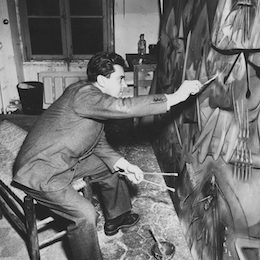Roberto Matta
1911 (Santiago du Chili) / 2002 ( Civitavecchia (Italie))
After meeting Breton in 1937, Matta soon appeared to be at the head of a brilliant pictorial production. "One of the most promising recruits for the Surrealists", wrote Breton: "In him, nothing is directed, nothing that does not result from the will to deepen the faculty of divination by means of colour, a faculty of which he is gifted to an exceptional degree" (The Minotaur).
His friend Gordon Onslow Ford pushed Matta from drawing to painting. Leonardo da Vinci suggested that you free your imagination by looking at the stains on the walls? Matta likes to "leonarder". He invents his own pictorial, mediumistic, automatic way: he lays a canvas on the ground, throws colours on it, then looks for them, afterwards, with a rag, with charcoal, with a brush, with the tube, with his fingers, with the knife. And he brings out images from a chaos of colours.
Morphology of desire, Morphologies of anguish, ... of hope... In 1938, Matta created his first psychological Morphologies, an approach that he would explore throughout his life, the true key to his work. In line with the theories of form - the Gestalt - which were new in France at the time, fascinated by "these incredible iconographies delivered by microscopes and telescopes", Matta approached the mystery of origins, "giving form to the most unbridled thoughts, creating a Hell-Paradise where everything is possible, and amplifying the panic that had seized space-time at the time of Cubism". Hence his sensational entry into the art world: "This non-painter preceded the general evolution of painting by ten years," says Alain Jouffroy.
After meeting Breton in 1937, Matta soon appeared to be at the head of a brilliant pictorial production. "One of the most promising recruits for the Surrealists", wrote Breton: "In him, nothing is directed, nothing that does not result from the will to deepen the faculty of divination by means of colour, a faculty of which he is gifted to an exceptional degree" (The Minotaur).
His friend Gordon Onslow Ford pushed Matta from drawing to painting. Leonardo da Vinci suggested that you free your imagination by looking at the stains on the walls? Matta likes to "leonarder". He invents his own pictorial, mediumistic, automatic way: he lays a canvas on the ground, throws colours on it, then looks for them, afterwards, with a rag, with charcoal, with a brush, with the tube, with his fingers, with the knife. And he brings out images from a chaos of colours.
Morphology of desire, Morphologies of anguish, ... of hope... In 1938, Matta created his first psychological Morphologies, an approach that he would explore throughout his life, the true key to his work. In line with the theories of form - the Gestalt - which were new in France at the time, fascinated by "these incredible iconographies delivered by microscopes and telescopes", Matta approached the mystery of origins, "giving form to the most unbridled thoughts, creating a Hell-Paradise where everything is possible, and amplifying the panic that had seized space-time at the time of Cubism". Hence his sensational entry into the art world: "This non-painter preceded the general evolution of painting by ten years," says Alain Jouffroy.
Artist's exhibitions
La Collection sort de sa Réserve ! - Exposition Collective
26/04/2021 - 01/09/2021
(Le François) Fondation Clément
26/04/2021 - 01/09/2021
(Le François) Fondation Clément
Vivantes natures
22/05/2017 - 05/11/2017
(Biron) Château de Biron
22/05/2017 - 05/11/2017
(Biron) Château de Biron
Dinard, l’Amour atomique
07/06/2013 - 01/09/2013
(Dinard) Palais des arts et du festival
07/06/2013 - 01/09/2013
(Dinard) Palais des arts et du festival
Matta : du Surréalisme à l’Histoire
15/02/2013 - 19/05/2013
(Marseille) Musée Cantini
15/02/2013 - 19/05/2013
(Marseille) Musée Cantini
